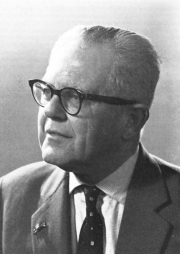Gerard Stuart
( economist) | |
|---|---|
 | |
| Born | 16 September 1893 's-Gravenhage, Netherlands |
| Died | 25 October 1969 (Age 76) Amsterdam, Netherlands |
| Nationality | Dutch |
| Alma mater | University of Groningen |
| Parents | • Coenraad Alexander Verrijn Stuart • Eva Anna Gunning |
| Spouse | Hester Jeanne Pino |
Dutch banker and economist. Attended the 1955 and 1956 Bilderberg meetings, before becoming an advisor in the preparation of the 1958 Treaty of Rome, which established the European Economic Community (EEC). | |
Dr Gerard Marius Verrijn Stuart was a Dutch economist, banker and chairman of the Social and Economic Council, a major economic advisory council to the cabinet of the Netherlands.[1]. He attended the 1955 and 1956 Bilderberg meetings, before becoming an advisor in the preparation of the 1958 Treaty of Rome, which established the European Economic Community (EEC).
Background
He was son of Coenraad Alexander Verrijn Stuart, professor of Economics, and Eva Anna Gunning. He married in 1921 to Hester Jeanne Pino. From this marriage, one son and one daughter were born. After her death in 1948, he married in 1950 to Helena Frederika Johanna Prior. No children were born of this marriage.[1]
Education
After a high school education in The Hague and Groningen, Verrijn Stuart studied law in the latter city, and also studied for a year in Zurich and Geneva. His doctoral examination in law took place in 1915. The promotion to Master in 1917 and his doctorate in 1919 both took place at the University of Groningen.[1]
Career
He was deputy agent of the Nederlandsche Bank in Groningen from 1917. In 1919 he was appointed to the Rotterdamsche Bankvereenigin, which in 1924/1925 sent him to Batavia in the Dutch East Indies as director of its subsidiary there.[1]
Meanwhile, in 1922, Verrijn Stuart obtained an extraordinary professorship in economics, special currency, credit and banking at the Nederlandsche Handels-Hoogeschool in Rotterdam. He accepted his teaching assignment with an oration on the value of money. In 1925 he succeeded prof. G. W. J. Bruins as ordinary professor of economics. During his professorship he wrote three widely used handbooks and textbooks.[1]
As a professor he was one of the first to give workshops. Verrijn Stuart was open to his students. Perhaps in addition to this capacity, his qualities as a textbook writer and as a teacher were instrumental in making him eligible to teach economics to Crown Princess Juliana in the year 1928/1929. Due to his work on behalf of the Stichting Nederlands Economisch Instituut, an institution for economic-analytical and empirical research, which is affiliated with the Hoogeschool, he was partially exempted from his professorship in 1931.[1]
In 1934, Verrijn Stuart left the School to succeed his father as Professor of economics at the University of Utrecht. He exchanged this position in 1939 for the directorship of the Amsterdamsche Bank; after his resignation as director in 1954, Verrijn Stuart was successively commissioner and President-commissioner of that bank. From December 1941 to August 1943 Verrijn Stuart was extraordinary professor in state economics. During the German occupation, he had people in hiding and his wife was active in the resistance.[1]
In 1952 he was again given an extraordinary professorship, now in international economic relations and banking at the University of Amsterdam, combined with the chairmanship of the board of trustees of the Foundation for Economic Research affiliated with that university.[1]
In addition to his positions at the Amsterdamsche Bank, Verrijn Stuart held various supervisory boards, advisory boards and memberships and chairmanships of government, state committees and associations. In 1950 he was appointed crown member of the then established Social and Economic Council; from 1958 to 1964 he was, as successor of prof. Frans de Vries, chairman of this council. He also worked in advisory roles in the Benelux and in the preparation of the 1958 Treaty of Rome, which established the European Economic Community (EEC). [1]
He received Belgian and Dutch awards, including in 1954 a membership of the Royal Netherlands Academy of Arts and Sciences.[1]
Events Participated in
| Event | Start | End | Location(s) | Description |
|---|---|---|---|---|
| Bilderberg/1955 March | 18 March 1955 | 20 March 1955 | France Barbizon | The second Bilderberg meeting, held in France. Just 42 guests, fewer than any other. |
| Bilderberg/1956 | 11 May 1956 | 13 May 1956 | Denmark Fredensborg | The 4th Bilderberg meeting, with 147 guests, in contrast to the generally smaller meetings of the 1950s. Has two Bilderberg meetings in the years before and after |